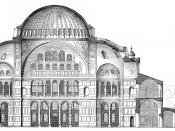The invention of the Christian church was one of the brilliant solutions in architectural history. This was achieved by a process of assimilating and rejecting various precedents, such as the Greek temple, the Roman public building, the private Roman house, and the synagogue. The Early Christian period saw the growth of Christianity. It was established as the state religion of the Empire under the successors of Constantine. Early Christian Architecture consisted of the basilica church developed from the Roman secular basilica. The sixth century was a time of growth for the Byzantine Empire. Many of the churches built during this time were of the basic basilica style. At least two developments began during this century. One involved small buildings with domed or niched interiors and the other the use of domed vaulting in the basilica. While it is difficult to generalize any architectural developments during this time, one of the most striking changes that can be found in many churches of this time is the use of the domed nave.
The domed nave was usually used with a rectangular or Latin cross plan. The Carolingian and Ottonian (merely a continuation of Carolingian period) periods consisted of mainly the basilica also. By the end of the pre-Romanesque period, Roman stylistic elements had fused with elements from Byzantium and the Middle East, and from the Germans, the Celts, and other northern tribes in Western Europe. These various combinations created a number of local styles, called Romanesque, meaning "in the manner of the Roman." An outstanding achievement of Romanesque architects was the development of stone vaulted buildings. To support the heavy stone vaults, architects used massive walls and piers, creating a typical building plan that treated the entire structure as a complex composed of smaller units, called bays. A distinguishing feature of Romanesque...


